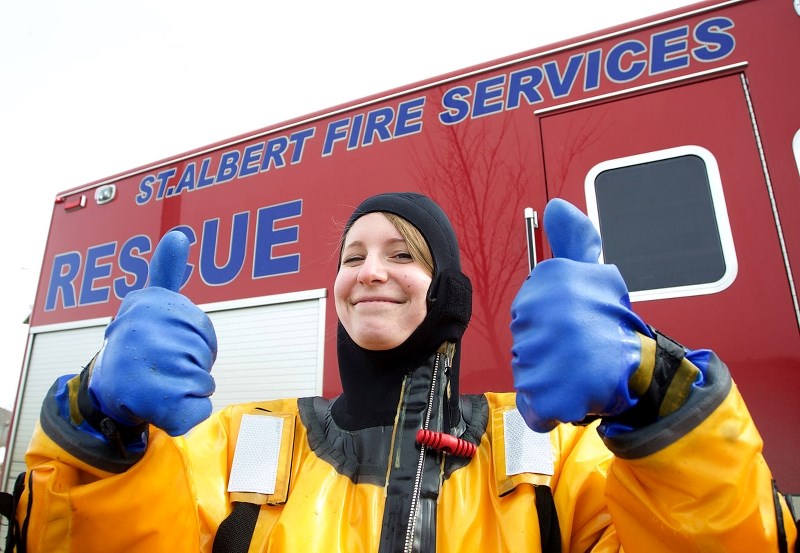“I’m here to rescue you,“ I say as I waddle across the frozen lake in my big, yellow nylon suit.
Firefighter Pete McDougal shoots me a smile. He’s stuck in a hole in the middle of frozen Giroux Lake, playing the victim during the St. Albert Fire Department’s twice-annual exercise in ice-water rescue. Meanwhile, I get to exercise first-person reporting by helping him out.
Before I reach the break in the ice, I lie down and slowly roll around the opening. If I stand on the thin ice, the weight might cause it to break. And “you don’t want to break the ice in front of (McDougal),” Lt. Paul Barbieri with Fire Station No. 3 told me earlier.
Luckily, McDougal is also wearing an insulated, ice commander rescue suit. Despite balmy 7 C weather, the lake remains covered in ice. And I’m not the first to rescue him.
I feel pretty successful in the exercise until I slide into the water and my suit turns into a balloon. My feet move back and float above the surface, while my upper body pushes me forward and my face splashes into the water. I feel like an unbalanced rubber duck.
The suit has an inner lining designed to keep the wearer warm and afloat. The outer part keeps me dry. It’s a one-piece, with boots and gloves attached, and a mask that covers my hair and neck. The mask also hinders any air from going out, unless you remember to lift it away from your face while pulling in your knees to push out the air.
Thankfully, I also wear weights around my ankles, which help me find my balance. As I decompress my suit, the water pressure tightens around my feet.
Barbieri says the department rarely uses the training. The last time was to rescue a dog. They still need to prepare for the worst.
Getting into the water is a last resort though. Victims panic, which can be dangerous for the firefighters. Rescuers first try to determine if the person can get out on their own or with the help of a rope. If that doesn’t work, someone goes in for the rescue.
“The odd time that we see people walking on the ice we tell them to stay off,” says Barbieri. He adds that there’s more than one rescuer on the ice in an emergency, in case one of them breaks through.
“If there was a real rescue you would have a plan of attack. You wouldn’t expect one person to do everything,” he says.” You would have three or four guys ready to go.”
To rescue McDougal, I brought a lifeline with me. One end of the rope is attached to my suit, while the other end is secured to an anchor point, such as a tree. I wrap the rope around his waist and secure it with a hook. Then I tap my head to signal the crew on the shore that it’s safe to pull us out.
I push his legs up as he gets out of the water and then we’re pulled across the ice. But I forget to wave to the crew on shore to tell them to stop and it’s safe to stand up. So we keep sliding across the lake.
Once we make it back to shore, McDougal and I switch roles. Now he rescues me. Maybe it’s better that way.
Ice safety guidelines
• Never walk on ice that is less than 10 cm (4 inches) thick, and never drive on ice that is less than 30 cm (12 inches) thick.<br />• Be extra cautious on river and stream ice. Ice can also vary in thickness and strength from area to area.<br />• Keep an eye on the ice and snow conditions ahead of you. Ice can bend and crack under the weight of people, vehicles or heavy snow.<br />• If you fall through ice in a car, exit your vehicle immediately.<br />• Swim to the edge of the ice and break your way until it can hold your weight.<br />• Crawl up on your belly and spread your weight as far as possible. Don’t push down on the ice with your arms or walk on it until the ice is thick enough.<br />• Remember to warm up as quickly as possible afterwards.




